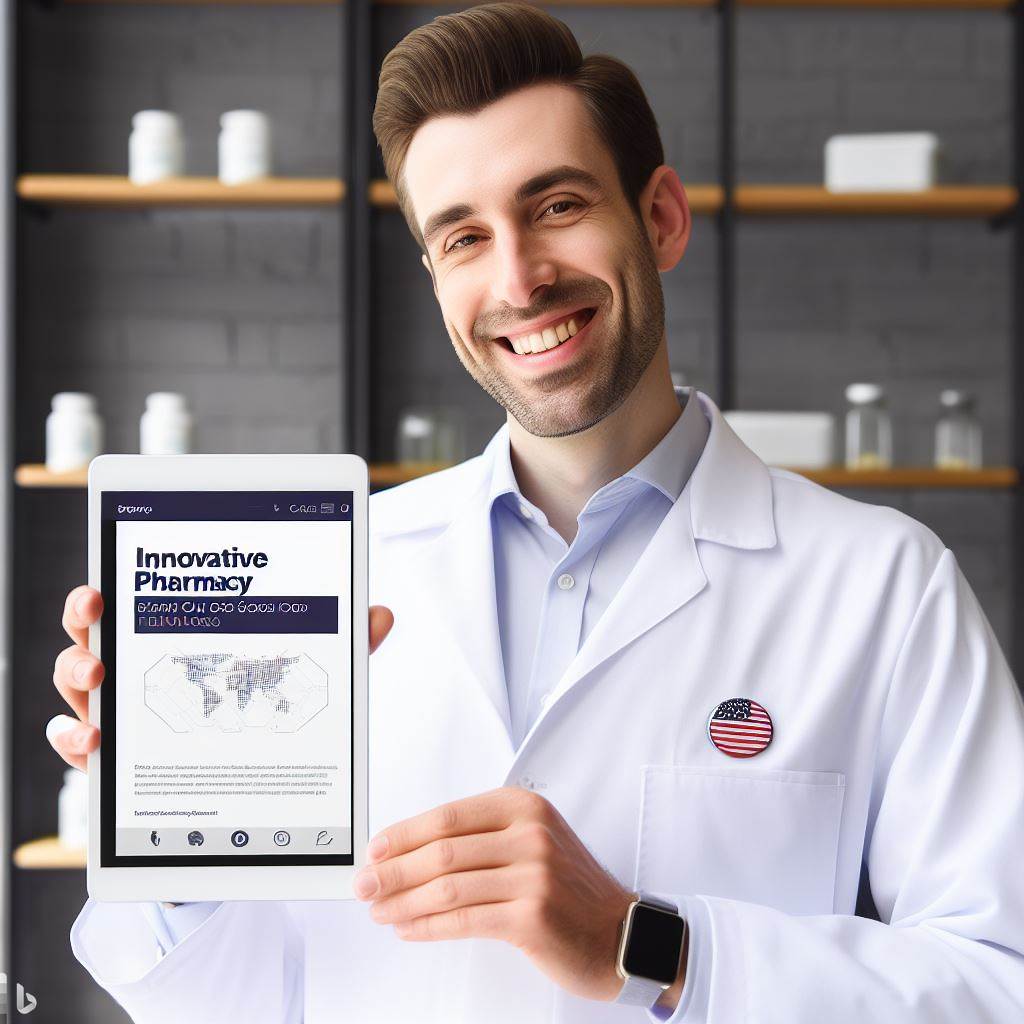Introduction
Drug distribution plays a crucial role in the healthcare system of the US, ensuring access to medications for patients.
Pharmacists, as key players in drug distribution, take on responsibilities beyond dispensing medications. They play an essential role in promoting patient safety and providing medication management services.
Through their expertise, pharmacists contribute to improving patient outcomes and reducing healthcare costs.
Importance of drug distribution in the US
Efficient drug distribution is vital to ensure patients receive the medications they need in a timely manner.
It involves various processes such as procurement, storage, inventory management, and distribution to different healthcare settings.
Drug distribution networks must be well-coordinated to prevent drug shortages and ensure the availability of essential medications.
Additionally, proper drug distribution promotes medication adherence and helps prevent medication-related problems, ultimately leading to better patient outcomes.
Role of pharmacists in the modern healthcare system
Pharmacists play a pivotal role in the modern healthcare system, particularly in drug distribution. They collaborate with healthcare teams to optimize medication therapy and ensure patient safety.
Pharmacists are responsible for verifying prescriptions, checking for drug interactions, and counseling patients on medication usage.
They also provide medication therapy management to improve patient adherence and prevent adverse drug events.
Moreover, pharmacists contribute to drug distribution by closely monitoring medication inventory and implementing quality control measures.
Their expertise extends beyond dispensing medications, making them essential contributors to the overall healthcare system.
Drug distribution is crucial in the US healthcare system, and pharmacists play a vital role in ensuring its efficiency.
Their responsibilities go beyond dispensing medications, as they contribute to patient safety, medication management, and healthcare cost reduction.
As the healthcare landscape evolves, pharmacists will continue to play a significant role in drug distribution and overall patient care.
Historical overview of drug distribution in the US
Evolution of the pharmacy profession
- In the early years, pharmacies were primarily owned and operated by physicians.
- During the mid-19th century, the pharmacy profession started to gain recognition and autonomy.
- The formation of the American Pharmaceutical Association in 1852 marked a significant milestone.
- Pharmacists became more involved in drug compounding and dispensing, focusing on patient care.
- With the passage of the Pure Food and Drug Act in 1906, pharmacists’ role in drug safety increased.
Transformation of drug distribution methods
- In the early 20th century, community pharmacies were the primary source of prescription drugs.
- Mail-order pharmacies gained popularity in the 1920s, providing convenient access to medications.
- The establishment of chain pharmacies in the 1950s revolutionized drug distribution.
- Chain pharmacies offered a broader range of services and streamlined drug supply chains.
- Towards the late 20th century, online pharmacies emerged, providing easy accessibility and competitive pricing.
The impact of technological advancements
- The automation of prescription dispensing systems improved medication accuracy and efficiency.
- Electronic health records and e-prescribing systems enhanced communication between healthcare providers and pharmacists.
- The implementation of barcode scanning and RFID technology reduced medication errors and improved inventory management.
- Technological advancements enable pharmacists to provide patient counseling and medication therapy management.
- Mobile applications and telepharmacy services have further expanded pharmaceutical care options for patients.
The historical overview of drug distribution in the US highlights the evolution of the pharmacy profession, the transformation of drug distribution methods, and the impact of technological advancements.
The pharmacy profession has evolved from being physician-dominated to gaining recognition as a separate healthcare profession.
Over the years, different drug distribution methods, including community, mail-order, chain, and online pharmacies, have emerged, enhancing patient access and convenience.
Technological advancements have significantly transformed the way pharmacists dispense medications, communicate with healthcare providers, and offer pharmaceutical care services.
As the role of the modern pharmacist continues to evolve, it is crucial to embrace these advancements and adapt to the changing landscape of drug distribution in the US.
Read: Rural vs. Urban Practice: Where to Set Up Shop in the U.S.
The role of modern pharmacists in drug distribution
Modern pharmacists play a significant role in the distribution of drugs in the United States.
They are not mere dispensers of medications but have expanded their responsibilities to ensure accuracy, safety, and patient education.
Dispensing prescription medications
One of the primary duties of modern pharmacists is dispensing prescription medications.
They carefully review prescriptions, verifying the appropriate dosages and ensuring the accuracy of the medication provided to patients. This helps prevent medication errors and ensures patient safety.
In addition to dispensing medications, pharmacists also play a crucial role in patient education.
They provide clear instructions on medication usage, including potential side effects and precautions to be taken.
This empowers patients to take their medications correctly, increasing the effectiveness of treatment and minimizing adverse effects.
Collaborating with healthcare professionals
Furthermore, pharmacists collaborate with healthcare professionals to optimize patient care.
They work closely with physicians, suggesting alternative medications or dosage adjustments to achieve the best possible outcomes for patients.
By actively participating in the healthcare team, pharmacists contribute to the overall well-being of patients.
Role in clinical services and specialized care
Pharmacists also consult with other healthcare providers, such as nurses or pharmacists in different specialties, to develop individualized treatment plans.
This collaboration ensures that the patient’s specific needs and circumstances are taken into account, resulting in optimal and personalized care.
Beyond their traditional roles, modern pharmacists are increasingly involved in providing clinical services and specialized care.
Medication therapy management is one such service, where pharmacists assess prescriptions for potential drug interactions or therapy optimization.
This proactive approach helps prevent adverse drug events and enhances medication efficacy.
Pharmacists are also authorized to administer immunizations, playing a vital role in promoting public health.
By providing vaccines, they contribute to the prevention and control of infectious diseases within the community.
This accessibility to immunizations makes pharmacists frontline healthcare providers in the fight against various illnesses.
Another important aspect of the modern pharmacist’s role is chronic disease management.
They work closely with patients suffering from chronic conditions, such as diabetes or hypertension, to ensure the proper management of their medications.
Pharmacists monitor medication regimens, provide necessary support, and offer counseling to help patients understand the importance of adherence.
Modern pharmacists have evolved from traditional medication dispensers to key players in the distribution of drugs in the US.
Their responsibilities encompass dispensing medications accurately, providing patient education, collaborating with healthcare professionals, and offering clinical services and specialized care.
Pharmacists’ active involvement improves patient outcomes, enhances safety, and contributes to the overall quality of healthcare in the United States.
Read: The Evolution of Medical Ethics in American Medicine
Explore Further: How to Start a Career as a Substance Abuse Counselor
Challenges faced by modern pharmacists in drug distribution
The opioid crisis and drug abuse
One of the most pressing challenges for modern pharmacists is the ongoing opioid crisis and rampant drug abuse.
Pharmacists play a crucial role in ensuring responsible opioid dispensing practices to prevent the misuse and diversion of controlled substances.
This involves rigorous monitoring of prescriptions, patient education, and adherence to state and federal regulations.
Furthermore, pharmacists are at the forefront of identifying and addressing potential addiction issues.
They are often the first healthcare professionals to encounter patients who may be struggling with drug abuse.
Pharmacists must be proactive in recognizing signs of addiction, providing appropriate counseling, and referring individuals to specialized treatment programs when necessary.
Insurance reimbursement and medication access barriers
Another significant challenge faced by modern pharmacists is navigating insurance reimbursement and medication access barriers.
The complexities of insurance approvals and formularies can delay patient access to necessary medications.
Pharmacists must work closely with insurance providers to ensure timely approvals and explore alternative options when coverage is denied.
Transform Your Career Today
Unlock a personalized career strategy that drives real results. Get tailored advice and a roadmap designed just for you.
Start NowAdditionally, many patients face financial constraints that prevent them from affording their medications.
Pharmacists often find themselves in the role of assisting patients in finding cost-effective alternatives, such as generic substitutions or patient assistance programs.
This requires knowledge of available resources and effective communication with patients to ensure they have access to the medications they need.
Technology and automation
The rapid advancement of technology and automation in the healthcare industry presents both opportunities and challenges for modern pharmacists.
Adapting to electronic health records (EHRs) and digital prescriptions requires pharmacists to embrace new systems and workflows.
This transition can be time-consuming and may initially affect efficiency in drug distribution.
However, EHRs and digital prescriptions have the potential to enhance patient safety, improve communication between healthcare providers, and streamline medication management.
Furthermore, there are concerns about potential job displacement due to automation.
As technology continues to evolve, there is a fear that certain tasks traditionally performed by pharmacists may be automated, potentially reducing the need for human intervention.
This challenge underscores the importance of pharmacists staying abreast of technological advancements and continuously expanding their skill set to remain valuable members of the healthcare team.
Modern pharmacists face various challenges in drug distribution. The opioid crisis and drug abuse present an ongoing and complex issue that pharmacists must navigate responsibly.
Insurance reimbursement and medication access barriers require pharmacists to be proactive advocates for their patients.
Technology and automation bring both opportunities and concerns, demanding continuous adaptation and professional growth.
Overcoming these challenges ensures that pharmacists can fulfill their vital role in safe and effective drug distribution to improve patient outcomes.
Read: Women in Medicine: Challenges and Triumphs in the U.S.

Future trends in drug distribution and the pharmacist’s role
Telepharmacy and remote prescribing
Firstly, Telepharmacy and remote prescribing are emerging trends that are expected to shape the future of drug distribution in the US.
Telepharmacy allows pharmacists to provide pharmaceutical care remotely, ensuring access to medications in underserved areas.
Through video conferences and advanced technology, pharmacists can assess patient needs and prescribe medication without physically being present.
This innovation in drug distribution not only improves access to medications but also enhances patient convenience and reduces healthcare costs.
Patients in remote areas can now receive the expert advice of pharmacists without traveling long distances.
Telepharmacy also enables pharmacists to monitor patients’ medication adherence and provide counseling in real-time.
Pharmacogenetics and personalized medicine
Another futuristic trend in drug distribution is the integration of pharmacogenetics and personalized medicine.
Pharmacogenetics is the study of genetic variations that influence an individual’s response to drugs.
By analyzing a patient’s genetic profile, pharmacists can customize medication regimens based on the individual’s specific needs.
This personalized approach to drug distribution ensures optimal therapeutic outcomes while minimizing adverse reactions and optimizing medication dosing.
By leveraging genetic data, pharmacists can identify patients who are more likely to benefit from certain medications and those who may experience harmful side effects.
Expansion of clinical pharmacy services
With an increasing focus on patient-centered care, the role of the pharmacist is expanding beyond traditional drug distribution.
Clinical pharmacy services, including medication therapy management, immunizations, and chronic disease management, are becoming integral components of modern pharmacy practice.
Pharmacists are collaborating with other healthcare professionals to provide comprehensive care to patients.
They are conducting medication reviews, identifying drug interactions, and optimizing therapeutic regimens to improve patient outcomes.
By actively engaging with patients, pharmacists are playing a vital role in preventing adverse drug events and promoting medication safety.
Integration of artificial intelligence in drug distribution
Artificial intelligence (AI) is revolutionizing various industries, and drug distribution is no exception.
AI technologies, such as machine learning and natural language processing, can streamline inventory management, automate prescription processing, and optimize medication dispensing.
AI-powered algorithms can identify patterns in medication use and predict patient needs, enabling pharmacists to proactively address medication shortages and ensure uninterrupted supply.
Automated systems can also flag potential medication errors, reducing the risk of dispensing mistakes.
The integration of AI in drug distribution enhances efficiency, accuracy, and safety, ultimately benefiting both patients and pharmacists.
The future of drug distribution in the US will witness significant advancements that redefine the pharmacist’s role.
Telepharmacy, pharmacogenetics, clinical pharmacy services, and artificial intelligence are just a few trends that will shape how medications are accessed, prescribed, and distributed.
By leveraging these innovations, pharmacists can provide personalized, efficient, and safe pharmaceutical care to meet the evolving needs of patients.
Read: America‘s Healthcare Rankings: How Do Doctors Make an Impact?
Uncover the Details: Day in the Life of a Health Educator
Conclusion
Recap on the Role of Modern Pharmacists in Drug Distribution
Modern pharmacists are at the forefront of drug distribution in the United States.
They have evolved into integral healthcare professionals, no longer confined to the traditional role of medication dispensers.
Pharmacists today are dynamic and versatile, contributing significantly to drug distribution while actively engaging in patient care.
The Importance of Their Contribution to Patient Care and Safety
Their role extends far beyond merely handing out medications.
Modern pharmacists offer invaluable services, such as medication counseling, monitoring for drug interactions, and providing education to patients on proper medication use.
They are pivotal in enhancing patient safety, improving adherence to treatment regimens, and ensuring optimal therapeutic outcomes.
The Ongoing Significance of Pharmacists in the Evolving Healthcare Landscape
As the healthcare landscape continues to evolve, the significance of pharmacists remains unwavering.
They are indispensable in addressing public health challenges, optimizing drug distribution systems, and playing a key role in interprofessional healthcare teams.
In an era marked by telehealth, technological advances, and changing patient demographics, pharmacists adapt and continue to shape the future of healthcare.
In this ever-changing landscape, pharmacists are not just dispensers of medications; they are healthcare partners who contribute significantly to the well-being of individuals and communities.
As healthcare adapts, pharmacists adapt with it, ensuring that drug distribution remains safe, efficient, and patient-centered, ultimately fostering healthier communities and improving the quality of healthcare for all.
Their role in healthcare is as vital as ever, and it will continue to grow in importance in the years to come.
Transform Your Career Today
Unlock a personalized career strategy that drives real results. Get tailored advice and a roadmap designed just for you.
Start Now[E-Books for Sale]
The Big Book of 500 High-Paying Jobs in America: Unlock Your Earning Potential
$19.99 • 500 High-Paying Jobs • 330 pages
Explore 500 high-paying jobs in America and learn how to boost your career, earn more, and achieve success!
See All 500 High-Paying Jobs of this E-Book
1001 Professions Without a Degree: High-Paying American Jobs You Can Start Now
$19.99 • 1001 Professions Without a Degree • 174 pages
Discover 1001 high-paying jobs without a degree! Unlock career tips, skills, and success strategies for just $19.99!




